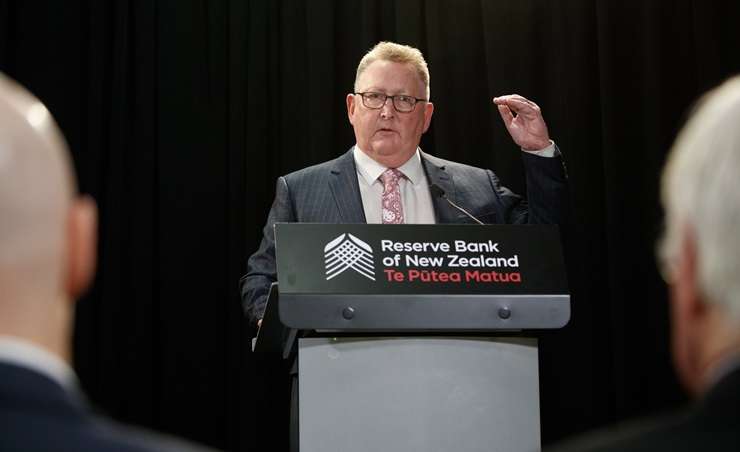Homeowners wait with bated breath for Reserve Bank announcements on the Official Cash Rate, knowing their mortgage rates might go up or down as a result but without necessarily understanding why. Then, just as rates are finally coming down, Donald Trump is re-elected as US president and there are immediate questions over whether his policies will impact Kiwi homeowners. Andrew Chambers, the CEO of digital mortgage company Tella, walks OneRoof through some of the concerns.
Q: What is the difference between the OCR (Official Cash Rate) and mortgage rates, and what is the connection between them?
The Official Cash Rate is an indicator rate set by the Reserve Bank. It provides a benchmark to the banks as to where rates (any fixed rate, from deposit rates to mortgage rates) should be and allows the Reserve Bank to influence pricing in general and to moderate inflation. It’s also used to set the pricing for overnight bank settlements, a function managed within the Reserve Bank.
Start your property search
Today, the OCR is seen as a pricing control for inflation. The Government’s main mandate for the RBNZ is to monitor and manage inflation, keeping it between 1% and 3% – not too hot, not too cold. The Government has recently trended towards limiting the powers of the RBNZ, maybe a backlash for the management through the Covid period. I personally think the RBNZ should be given more powers and more scope to build New Zealand’s capital markets and competition within it.
Q: The Reserve Bank reviews the OCR seven times a year and recently began an expected series of cuts – why don’t banks’ mortgage rate cuts ever come down as much as the OCR cuts?
Bank rates are not directly tied to the OCR and, in fact, banks move their rates in connection with their own needs while keeping in mind the OCR as a benchmark. At times the banks will have already predicted a drop/rise in advance of an OCR announcement by the RBNZ and will have “priced” it in advance. Other times they’ll lag.
Discover more:
- Mortgage forecast: Just how low will interest rates go in 2025?
- Revealed: The hot 100 New Zealand suburbs to watch
- Mum transforms plaster townhouses into Airbnb money-spinners
They won’t always move at the same time. Banks have their own balance sheet management to consider. They take deposits and borrow from other wholesale lenders in order to lend to their own clients. As such they have to be constantly matching their deposit and loan terms.
Imagine they have five buckets – a bucket for one-year fixed through to five years fixed. If they have $10m in the term deposits bucket fixed for one year, then they can only lend $10m in home loans fixed for one year. If they have too much in a bucket, they need to lend it, and if they don’t have enough, they need to borrow it. So rates also feel the effect of these movements and if a bank is borrowing wholesale funds from another bank etc.
Q: The best mortgage rate out there still a full percentage point higher than the OCR – why is that?
The OCR is the rate the RBNZ pay for deposits with and if a bank was to borrow from the RBNZ it would pay OCR plus 0.50%. So, borrowing rates are always higher. But banks are also commercial, and their profit comes from the margin between what they pay for deposits and lend at. It’s called the net interest margin and the higher it is the more profitable they will be.

Tella mortgages CEO Andrew Chambers: "I personally think the RBNZ should be given more powers and more scope to build New Zealand’s capital markets." Photo / Supplied
New Zealand’s banks are some of the most profitable banks on earth and have very strong net interest margins. Many commentators would say bank margins are excessive but the banks would counter this and say they are a sign of a solid and safe banking environment. Most New Zealand banks currently have net interest margins over 2.4% – this is the gap between what you as the consumer pays for your home loan and received on your term deposit.
Q: Banks often cut their mortgage rates ahead of the Reserve Bank’s OCR announcements – should we still take our lead on where mortgage rates are headed from the OCR?
Yes, the OCR is a great indicator as to where banks are heading with rates. But it’s not the only rate indicator. We can look at what wholesale rates are doing as an example. Here, we can look at swap rates as a guide.
A way of thinking about it is a one-year swap rate is where the market thinks rates will be in one year’s time and a five-year swap rate is where the market thinks rates will be in five years’ time. The line across this timeline is called a yield curve and indicates the direction rates are going. At the moment, if we look at swap rates, that curve is flat with a one-year swap rate of 4.6% and five years at 4.1%.
Q: Do banks follow the Reserve Bank – or does the Reserve Bank really follow the banks?
Banks follow the market so cast your eyes wide – look at the OCR but also look across the banks. There will always be market takers who want to buy business and build market share and this will change from time to time.
An example of this recently has been Kiwibank coming off a low base and looking to build their balance sheet. Kiwibank’s net interest margin is lower than the four big banks as it’s paid more for deposits and less on home loans in order to buy the business, a sometimes-necessary strategy for growth.
Q: Is there a better way than the OCR to control inflation?
Controlling inflation is largely about controlling consumer spending. More spending creates an expansion in economic activity and less spending, a contraction. So, by putting rates up, the cost of interest on loans goes up and if you are paying more on your mortgage you’re spending less on other things. It takes money out of circulation and causes an economic contraction. The issue with this model is that it not only impacts households spending, but it also impacts their long-term wealth.

Reserve Bank of New Zealand Governor Adrian Orr has charted a cautious course this year. Photo / Mark Mitchell
If household wealth is impacted, our long-term prosperity as a nation is impacted. There are many other ways to create similar effect, some good and some not so good. You could increase tax, moving household income to government income, not a bad long-term outcome – but voters hate paying more tax. Or you could increase the mandatory savers for KiwiSaver from 3% of income to 10% of income. This gets an amazing outcome as the individuals spend less controlling inflation but save more for their future retirement.
Q: What other tools does the Reserve Bank have available to fight inflation?
They can slow down the ease with which the banks offer credit. Less lending equals less spending and less money in circulation. Measures like the Loan-to-Value ratios and Debt-to-Income ratios are measures that restrict the flow of credit and are counter-inflationary.
Q: America just re-elected Donald Trump – will he make our mortgages cheaper or more expensive?
The US has been doing very well over a number of years. I think there is a good chance this will continue under Trump as he is pro-business and has a domestic focus. The US is still a powerhouse economy with high GDP and wealth beyond most nations and it’s still a tech leader.

Donald Trump re-election to the White House in the US has implications for the world economy. Photo / Doug Mills, The New York Times
Trump seems to have focused on the latter and gained the support of the tech leaders in this election. The question to ask is, will he be a peace-maker or a war-maker. Globally, we need to move back to a global view and away from domestic patriotism in order to foster strong trading relationships and we need for US, China and the EU to be working well together. It’s important for New Zealand as an export-led economy to have this stability for both growth and access to low-cast capital and interest rates.
Q: What else should we be worrying about which is going to impact mortgage rates?
We do need competition in our banking sector. Our New Zealand banks desperately need to be capitalised, and I mean all of them, not just Kiwibank. Without greater competition we won’t have an active and vibrant capital markets, we’ll have less skills and expertise in the section and less sophisticated products and services.
Q: What is top of mind when people contact your mortgage advisers?
At the moment, it’s ‘How much will it cost me to break out of my current interest rate?’ With rates coming down the pain of being stuck in a higher interest rate is real. My advice to people is that you bought your home as a long-term investment, sometimes for life, and rates will go up and down but it all washes out over a 20-year horizon so take the lows with the highs. Banks can always provide cost to break if requested but unfortunately, it’s always higher on a downward rate cycle.
Q: Have you noticed a change in first-home buyer sentiment?
Rates coming back is a huge driver for first-home buyers as it helps with serviceability. Tella is seeing higher enquiry around affordability than we have seen in recent months. Conditions really favour them at the moment with banks very open to low deposit first-home buyers, incomes having increased on average over the last four years and both valuations and interest rates coming down. Valuations may have plateaued so I would be making the most of it in the coming months if I was buying my first home – get in before FOMO sets back in.
* OneRoof has a home loan partnership with Tella.
- Click here to find more properties for sale





















































































